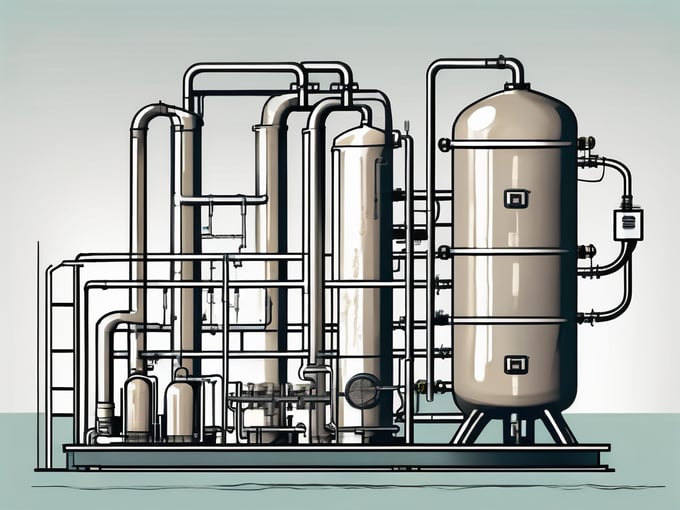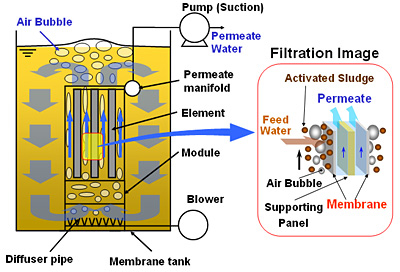Innovations in Membrane Bioreactor Technology for Enhanced Environmental Sustainability
Innovations in Membrane Bioreactor Technology for Enhanced Environmental Sustainability
Blog Article
Just How Membrane Bioreactors Are Transforming Water Purification Equipments
The introduction of membrane layer bioreactors (MBRs) represents a significant innovation in the area of water filtration, merging organic treatment processes with innovative membrane filtration innovations. This integration not only improves the high quality of dealt with effluent but also addresses metropolitan area constraints, making MBRs particularly suitable for largely populated areas. As global water shortage magnifies, the function of MBRs in assisting in potable water reuse and sustainable water management comes to be increasingly vital. The effects of this technology prolong beyond efficiency-- what chances and challenges exist in advance for its prevalent execution?
Overview of Membrane Bioreactors
Membrane layer bioreactors (MBRs) stand for a substantial development in water filtration technology, as they incorporate biological treatment procedures with membrane filtering. This combination enhances the efficiency of wastewater treatment by making use of bacteria to degrade natural toxins while concurrently utilizing semi-permeable membrane layers to separate cured water from put on hold solids and pathogens.
The MBR system generally contains a biological activator where the microbial population metabolizes impurities, adhered to by a membrane layer filtering system that maintains biomass and enables just clean water to pass through. This double capability results in higher effluent high quality compared to conventional treatment approaches. MBRs can be operated in both batch and continual flow settings, using flexibility in design and application.
They additionally allow the recuperation of water for reuse, therefore contributing to water sustainability initiatives. In general, MBRs are at the leading edge of boosting water therapy effectiveness and top quality, showcasing the capacity for ingenious services in ecological monitoring.
Benefits of MBR Modern Technology
The combination of organic treatment with membrane filtering provides various advantages for water purification procedures. Among the main benefits of Membrane Bioreactor (MBR) technology is its capacity to properly get rid of both inorganic and natural contaminants, resulting in premium effluent. The membranes serve as a physical barrier, protecting against put on hold solids and virus from going through, which improves the total security and dependability of cured water.
In addition, MBR systems need a smaller impact contrasted to conventional treatment methods, enabling much more efficient room usage. This compact layout is specifically helpful in city settings where land is restricted. MBRs additionally show functional versatility, fitting varying influent qualities and flow rates without significant performance deterioration.
Moreover, the procedure provides improved nutrient elimination abilities, especially for nitrogen and phosphorus, which are critical for protecting against eutrophication in obtaining waters. The decreased sludge production connected with MBR innovation additionally translates to lower disposal expenses, making it an economical option over time - Membrane Bioreactor. Overall, the advantages of MBR innovation setting it as a leading option for innovative and lasting water filtration systems, resolving both ecological and economic concerns
Applications in Water Filtration
Applications of Membrane Bioreactor (MBR) technology in water purification are varied and impactful, attending to different therapy needs across numerous markets. MBRs properly integrate biological treatment processes with membrane layer purification, making them suitable for metropolitan wastewater treatment, industrial effluent management, and even safe and clean water reuse initiatives.
In community settings, MBRs are significantly employed to boost the top quality of treated wastewater, enabling compliance with rigorous discharge policies and promoting the recycling of water for irrigation and non-potable uses. Their portable style likewise makes them appropriate for metropolitan environments where area is limited.
Industrially, MBR modern technology is utilized to treat process water and wastewater, particularly in sectors such as food and beverage, pharmaceuticals, and textiles. By effectively getting rid of pollutants and put on hold solids, MBRs assist sectors decrease environmental effects while recouping important sources from wastewater streams.
Additionally, MBRs are getting traction in decentralized water treatment applications, where small systems can be deployed in remote areas or developing regions. This adaptability makes it possible for neighborhoods to achieve sustainable water monitoring remedies, improving accessibility to tidy water while lowering reliance on traditional therapy techniques.
Instance Researches and Success Stories

In another instance, a textile production facility in Bangladesh embraced MBR modern technology to resolve its wastewater challenges. The system lowered chemical oxygen need (COD) degrees from 1,200 mg/L to less than 100 mg/L, therefore meeting regulatory standards and significantly decreasing environmental influence.
The University of Cape Town's MBR installation has actually verified efficient in treating greywater for non-potable reuse on university. This task not only preserves drinkable water yet also functions as an academic model for lasting techniques.
In addition, a seafood handling plant in Norway used MBR innovation to treat effluents having high degrees of organic matter, achieving over 90% toxin elimination. These case research studies emphasize MBR innovation's flexibility and its essential duty in improving water quality throughout diverse applications.
Future of Water Treatment Solutions
As worldwide water deficiency websites and contamination challenges escalate, cutting-edge water therapy options are coming to be significantly essential to make sure lasting access to tidy water. The future of water therapy hinges on the assimilation of advanced technologies that enhance the performance and performance of purification processes. Membrane layer bioreactors (MBRs) are at the center of this advancement, incorporating organic treatment with membrane layer purification to generate premium effluent ideal for numerous applications.

Emerging fads such as source healing from wastewater, consisting of nutrients and energy, will certainly additionally change treatment facilities right into environmentally friendly centers. Additionally, developments in nanotechnology and membrane layer products promise boosted performance and long life of filtration systems.

Conclusion
Their function in click for source drinkable water reuse and lasting water management highlights their importance in resolving global water scarcity challenges. Continued research and development will even more boost the efficacy and adoption of MBR technology, making sure a resistant future for water therapy remedies.
The appearance of membrane layer bioreactors (MBRs) represents a considerable innovation in the field of water purification, combining organic treatment processes with advanced membrane layer purification technologies. As global water shortage increases, the duty of MBRs in helping with potable water reuse and lasting water administration becomes increasingly essential. They additionally allow the healing of water for reuse, thus contributing to water sustainability efforts.As global water shortage and contamination challenges escalate, cutting-edge water treatment remedies are coming to be significantly important to make certain sustainable access to clean water. Their duty in drinkable water reuse and lasting water administration highlights their significance in dealing with global water deficiency obstacles.
Report this page